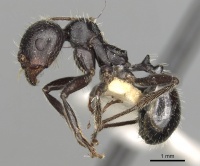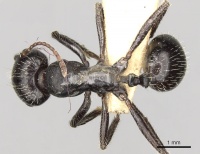Messor hispanicus
| Messor hispanicus | |
|---|---|

| |
| Scientific classification | |
| Kingdom: | Animalia |
| Phylum: | Arthropoda |
| Class: | Insecta |
| Order: | Hymenoptera |
| Family: | Formicidae |
| Subfamily: | Myrmicinae |
| Tribe: | Stenammini |
| Genus: | Messor |
| Species: | M. hispanicus |
| Binomial name | |
| Messor hispanicus Santschi, 1919 | |
Identification
Keys including this Species
Distribution
Latitudinal Distribution Pattern
Latitudinal Range: 41.083333° to 32.249974°.
| North Temperate |
North Subtropical |
Tropical | South Subtropical |
South Temperate |
- Source: AntMaps
Distribution based on Regional Taxon Lists
Palaearctic Region: Balearic Islands, Gibraltar, Iberian Peninsula, Morocco, Portugal, Spain (type locality).
Distribution based on AntMaps
Distribution based on AntWeb specimens
Check data from AntWeb
Countries Occupied
| Number of countries occupied by this species based on AntWiki Regional Taxon Lists. In general, fewer countries occupied indicates a narrower range, while more countries indicates a more widespread species. |

|
Estimated Abundance
| Relative abundance based on number of AntMaps records per species (this species within the purple bar). Fewer records (to the left) indicates a less abundant/encountered species while more records (to the right) indicates more abundant/encountered species. |

|
Biology
Castes
Nomenclature
The following information is derived from Barry Bolton's Online Catalogue of the Ants of the World.
- hispanicus. Messor barbarus st. hispanicus Santschi, 1919e: 244 (w.) SPAIN.
- Type-material: holotype worker.
- Type-locality: Spain: Ciudad Real, Pozuelo de Calatrava (J.M. de la Fuente).
- Type-depository: NHMB.
- Menozzi, 1922b: 326 (q.); Rodríguez González, et al. 1983: 38 (m.).
- As unavailable (infrasubspecific) name: Emery, 1922c: 95.
- Subspecies of barbarus: Menozzi, 1922b: 326; Ceballos, 1956: 301.
- Subspecies of structor: Santschi, 1929e: 144.
- Status as species: Santschi, 1927c: 225; Collingwood & Yarrow, 1969: 63; Collingwood, 1978: 81 (in key); Bolton, 1995b: 254; Espadaler, 1997b: 30; Cagniant & Espadaler, 1998: 431; Collingwood & Prince, 1998: 14 (in key); Cagniant, 2006a: 197; Borowiec, L. 2014: 106; Lebas, et al. 2016: 292; Barech, et al. 2020: 16.
- Distribution: Gibraltar, Morocco, Portugal, Spain (+ Balearics).
Description
References
- Barech, G., Khaldi, M., Espadaler, X., Cagniant, H. 2020. Révision taxonomique du genre Messor (Hymenoptera, Formicidae) au Maghreb et description de Messor hodnii sp. n., une nouvelle espèce de fourmi trouvée en Algérie. Revue suisse de Zoologie 127(1) : 9-19 (doi:10.35929/RSZ.0002).
- Borowiec, L. 2014. Catalogue of ants of Europe, the Mediterranean Basin and adjacent regions (Hymenoptera: Formicidae). Genus (Wroclaw) 25(1-2): 1-340.
- Cantone S. 2017. Winged Ants, The Male, Dichotomous key to genera of winged male ants in the World, Behavioral ecology of mating flight (self-published).
- Collingwood, C. A.; Yarrow, I. H. H. 1969. A survey of Iberian Formicidae (Hymenoptera). EOS. Rev. Esp. Entomol. 44: 53-101 (page 63, Raised to species)
- Collingwood, C.A., Prince, A. 1998. A guide to ants of Continental Portugal (Hymenoptera: Formicidae). Boletim da Sociedade Portuguesa de Entomologia. Supl nº5, pp 49.
- Menozzi, C. 1922c. Contribution à la faune myrmécologique de l'Espagne. Bol. R. Soc. Esp. Hist. Nat. 22: 324-332 (page 326, queen described)
- Orou, N., Csősz, S., Arnan, X., Pol, R. G., Arthofer, W., Schlick-Steiner, B. C., Steiner, F. M. 2023. Messor erwini sp. n., a hitherto cryptic harvester ant in the Iberian Peninsula. Zoologischer Anzeiger 307, 36–53 (doi:10.1016/j.jcz.2023.09.001).
- Plowes, N.J.R., Johnson, R.A., Holldobler, B. 2013. Foraging behavior in the ant genus Messor (Hymenoptera: Formicidae: Myrmicinae). Myrmecological News 18, 33-49.
- Rodríguez, A.; Reyes, J. L.; Espadaler, X. 1983. Descripción del macho de Messor hispanicus Santschi, 1919 (Hym., Formicidae). Bol. Asoc. Esp. Entomol. 7: 37-42 (page 38, male described)
- Santschi, F. 1919e. Fourmis d'Espagne et des Canaries. Bol. R. Soc. Esp. Hist. Nat. 19: 241-248 (page 244, worker described)
- Santschi, F. 1927d. Revision des Messor du groupe instabilis Sm. (Hymenopt.). Bol. R. Soc. Esp. Hist. Nat. 27: 225-250 (page 225, Raised to species)
- Santschi, F. 1929e. Fourmis du Maroc, d'Algérie et de Tunisie. Bull. Ann. Soc. Entomol. Belg. 69: 138-165 (page 144, Stirps of structor)
References based on Global Ant Biodiversity Informatics
- Acosta, F. J., M. D. Martínez Ibáñez, and M. A. Morales. "Contribución al conocimiento de la mirmecofauna del encinar peninsular. I." Boletín de la Asociación Española de Entomología 6 (2) (1983): 379-391.
- Acosta, F. J.. Las comunidades de hormigas en las etapas seriales del encinar. Madrid: Universidad Complutense, 1980.
- Asociacion Iberica de Mirmecologia. 2011. List of species collected during the Taxomara Lisboa 2010. Iberomyrmex 3: 32-33.
- Azcarate F. M., and B. Peco. 2012. Abandonment of grazing in a mediterranean grassland area: consequences for ant assemblages. Insect Conservation and Diversity 5: 279288.
- Azcarate, F.M. and B. Peco. 2003. Effects of seed predation by ants on Mediterranean grassland related to seed size. Journal of Vegetation Science, 17(3):353-360.
- Borowiec L. 2014. Catalogue of ants of Europe, the Mediterranean Basin and adjacent regions (Hymenoptera: Formicidae). Genus (Wroclaw) 25(1-2): 1-340.
- Borowiec L., and S. Salata. 2017. New records of ants (Hymenoptera: Formicidae) from southern Portugal. Acta Entomologica Silesiana 25(3): 1-10.
- Cagniant, H. 2006. Liste actualisée des fourmis du Maroc. Myrmecologische Nachrichten 8: 193-200.
- Cagniant, H., and X. Espadaler. "Le genre Messor au Maroc." Annales de la Société Entomologique de France (N.S.) 33 (4) (1998): 419-434.
- Cagniant, H.. "Liste actualisee des fourmis du Maroc (Hymenoptera: Formicidae)." Myrmecologische Nachrichten 8 (2006): 193-200.
- Cammell, M. E., M. J. Way, and M. R. Paiva. "Diversity and structure of ant communities associated with oak, pine, eucalyptus and arable habitats in Portugal." Insectes Sociaux 43 (1996): 37-46.
- Carpintero S., and J. Reyes-Lopez. 2013. Effect of park age, size, shape and isolation on ant assemblages in two cities of Southern Spain. Entomological Science doi:10.1111/ens.12027
- Carpintero, S., A. Tinaut, J. Reyes, and L. Arias. "Estudio faunístico de los formícidos (Hymenoptera: Formicidae) del Parque Nacional de Doñana." Boletín de la Asociación Española de Entomología 25 (1-2) (2001): 133-152.
- Collingwood C., and A. Prince. 1998. A guide to ants of continental Portugal (Hymenoptera: Formicidae). Boletim da Sociedade Portuguesa de Entomologia. Suplemento 5: 1-49.
- Collingwood, C. A., and I. H. H. Yarrow. "A survey of Iberian Formicidae." EOS (Revista española de entomología) 44 (1969): 53-101.
- Emery, C.. "Messor barbarus (L.). Appunti de sinonimia e di sistematica." Bollettino della Società Entomologica Italiana 54 (1922): 92-99.
- González Martín J. D., and X. Espadaler. 2011. Formicidos del País Vasco (Hymenoptera: Formicidae): Nuevas aportaciones. Heteropterus Revista de Entomologia 11(1): 109-122.
- Luque G. M., J. Reyes-Lopez, and Fernandez-Haeger. 2007. Recovery of Ground Ant (Hymenoptera: Formicidae) Communities Six Years After a Major Environmental Disaster. Environ. Entomol. 36(2): 337-347.
- Reyes, J. L.. "Descripción de Messor celiae nov. sp." Boletín de la Asociación Española de Entomología 9 (1985): 255-261.
- Rodríguez A., J. L. Reyes, and X. Espadaler. 1983. Descripción del macho de Messor hispanicus Santschi, 1919 (Hym., Formicidae). Bol. Asoc. Esp. Entomol. 7: 37-42.
- Sanchez-Gil Jimeno R., and J. L. Reyes-Lopez. 2016. Study of ants species of the Sierra de San Carlos del Valle (Ciudad Real) and updating the provincial check list (Hymenoptera, Formicidae). Boln. Asoc. esp. Ent. 40 (1-2): 93-109.
- Santschi, F.. "Fourmis d'Espagne et des Canaries." Boletín de la Real Sociedad española de Historia natural (Madrid) 19 (1919): 241-248.
- Tinaut A. 2016. Ants of the Tejeda, Almijara and Alhama Mountains Natural Park (Andalusia, Spain) (Hymenoptera, Formicidae). Boln. Asoc. esp. Ent., 40 (1-2): 125-159.

